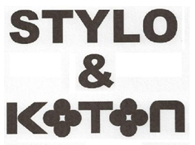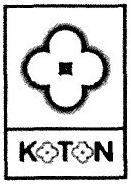
1. Hechos.
El 25 de abril de 2011, el Sr. Nadal presentó en la EUIPO – en clases 25, 35, 39- la solicitud de marca
Frente a esta solicitud, la Firma turca Koton Magazacilik Tekstil Sanayi ve Ticaret AS (en adelante KOTON) presentó oposición alegando la incompatibilidad de la marca solicitada con las marcas anteriores maltesa e internacional designando algunos países de la Unión Europea, registradas en clases 18, 25 y 35, con el siguiente distintivo.
La División de Oposición estimó la oposición respecto a los productos y servicios de las clases 25 y 35. Sin embargo, en resolución confirmada por la Sala de Recursos, la desestimó en clase 39, por lo que la marca quedó registrada para esta clase con fecha de 5 de noviembre de 2014. Ante tal circunstancia, KOTON presentó en la EUIPO el 5 de diciembre de 2014, una solicitud de nulidad alegando la mala fe del solicitante.
La petición de nulidad fue desestimada por la División de Anulación y, posteriormente, por la Sala de Recursos. Para ello, la Sala de Recursos estableció que –aunque hubiera similitud entre los signos y conocimiento de las marcas anteriores- no existía mala fe pues no había identidad o similitud entre los productos/servicios para los que se habían registrado las marcas anteriores (clases 18, 25 y 35) y los servicios de la marca impugnada (clase 39).
El recurso ante el Tribunal General también fue desestimado mediante sentencia de 30 de noviembre de 2017 (T-687/16 [en inglés]). El TG fundamentó su decisión en que- a pesar de haberse acreditado la existencia de una relación comercial previa entre las partes y el conocimiento de las marcas anteriores- no se podía aplicar el artículo 52. 1 b) RMUE (en la actualidad, artículo 59.1 b RMUE) ya que “la marca impugnada se registró para servicios diferentes a los designados por las marcas anteriores, excluyendo con ello cualquier riesgo de confusión entre las marcas en conflicto”.
Interpuesto recurso de casación, el TJ lo estima anulando la sentencia del TG y la previa resolución de la Sala de Recursos.
2. Pronunciamientos.
El TJ parte de un concepto de mala fe que presupone la presencia de una intención deshonesta por el solicitante de la marca. Además, señala que la finalidad del artículo 52. 1 b) RMUE (actual artículo 59) es la de impedir el registro de marcas cuyo objetivo o intención es la de menoscabar, de un modo no conforme con las prácticas leales, los intereses de terceros, o con la intención de obtener, sin tener si quiera la mira puesta en un tercero en particular, un derecho exclusivo con fines diferentes a los correspondientes a las funciones de la marca, sobre todo a la función esencial de indicación de origen.
El TJ reitera que la intención del solicitante es clave para determinar si existe o no mala fe. Además, manifiesta que este factor, aunque subjetivo, debe ser determinado de forma objetiva teniendo en cuenta todas las circunstancias fácticas del asunto. Entre tales circunstancias pueden incluirse las referentes a la existencia de un riesgo de confusión, pero si bien esa circunstancia pudo ser tenida en cuenta en la sentencia de 11 de junio de 20019 (C-529/07) de la citada sentencia no se desprende que la existencia de mala fe pueda únicamente estimarse en el supuesto en el que en el mercado se utiliza un signo idéntico o similar para productos idénticos o similares que puedan confundirse con el signo cuyo registro se ha solicitado.
Sobre la base de esta premisa, el TJ señala que la causa de nulidad por mala fe es distinta de la basada en el riesgo de confusión (artículo 8.1 b RMUE) y no exige para su aplicación que quien insta la nulidad sea titular de una marca anterior para productos o servicios idénticos o similares. Tampoco será necesario acreditar la concurrencia de un riesgo de confusión. Por ello- concluye la sentencia- procede declarar que “aunque no haya riesgo de confusión entre el signo utilizado por un tercero y la marca impugnada o no haya utilización por parte de un tercero de un signo idéntico o similar a la marca impugnada, otras circunstancias fácticas podrán constituir, en su caso, indicios pertinentes y concordantes que determinen la mala fe del solicitante”.
A continuación, el TJ deja muy claro que el momento en que debe analizarse la intención del solicitante es el coincidente con la fecha en que se solicitó la marca. Y en el presente caso- entre las circunstancias a valorar- cobra particular importancia que la marca no solo se solicitó para la clase 39, sino también para productos de las clases 25 y 35 englobados en el sector textil donde KOTON sí había utilizado un signo que incluía el elemento denominativo y figurativo objeto de la controversia.
Por ello- y con independencia de que en relación con la clase 39 no habría similitud aplicativa- el TJ manifiesta que, aunque el Tribunal General mencionó la lógica comercial en la que se inscribe la presentación de la solicitud de registro y la cronología de los acontecimientos que han llevado a dicha presentación, no los examinó exhaustivamente, limitándose a señalar que para apreciar la mala fe debía acreditarse la utilización de un signo idéntico o similar para productos o servicios idénticos o similares a aquellos para los que la marca impugnada había sido registrada, lo cual, por otra parte, implicaba conferir un alcance demasiado restrictivo al artículo 52. 1 b) RMUE (actual artículo 59). De ahí que el TJ concluya estimando el recurso.
3. Comentario.
En la sentencia de 11 de junio de 2007 (C-529/07) el TJ estableció como uno de los factores a tener en cuenta para apreciar la mala fe del solicitante el referente, en particular, “al hecho de que el solicitante sepa o deba saber que un tercero utiliza, en al menos un Estado miembro, un signo idéntico o similar para un producto idéntico o similar que puede dar lugar a confusión con el signo cuyo registro se solicita”.
Del enunciado de esta premisa se podría deducir que los factores para determinar la existencia de mala fe serían los mismos que los utilizados para aplicar la prohibición relativa al riesgo de confusión entre marcas. Pues bien, la sentencia que comentamos disipa cualquier duda al efecto y deja sentado de manera clara que los factores de confundibilidad no son esenciales para determinar si existe o no mala fe. Asimismo, debemos recordar que tal doctrina ha sido también confirmada por la ulterior sentencia del TJ de 13 de noviembre de 2019, C-528/18 P [en inglés], OUTSOURCE 2 INDIA (ver supra).
La mala fe, como concepto indeterminado y derivado de la intencionalidad subjetiva del solicitante, se debe objetivar mediante el análisis de las concretas circunstancias que concurren en la conducta del solicitante al pedir la marca. Además, tal análisis se debe realizar sin tener en cuenta, en el punto de partida, si entre los signos enfrentados existe o no semejanza o se aplican a productos o servicios idénticos o similares. Si así fuera, el TJ habría desestimado el recurso de casación interpuesto por KOTON pues- como previamente habían mantenido la EUIPO y el TG- la marca que se pretendía anular distinguía servicios (transporte …. Clase 39) diferentes a los productos que cubría el signo (marca) anterior (prendas de vestir…clase 25).
El TJ parte de un enfoque completamente distinto. Es cierto que la circunstancia de confundibilidad entre los signos y productos/servicios puede ser- al menos en mi opinión- tenida en cuenta al momento de analizar la mala fe; pero esta es una circunstancia como puede haber otras más. Sin embargo, lo determinante y fundamental para corroborar si hay o no mala fe será comprobar la “intencionalidad” del solicitante a la hora de pedir la marca. Y habrá mala fe- según deducimos de la sentencia comentada- si se solicita una marca que, a la vista del conjunto de tal solicitud, se aprecia que va enfocada a distinguir productos o servicios relacionados con un sector comercial en el que opera el signo cuyo conocimiento se presume que tuvo el solicitante; en el presente caso el sector textil ya que la marca impugnada en clase 39 ( transporte……sin especificar el sector) – y siguiendo una lógica desde el punto de vista comercial- debe entenderse como referida a ese sector según se deriva del resto de enunciados solicitados en la misma ( por ejemplo, prendas de vestir…..clase 25).
Por ello- y para finalizar este comentario- podemos señalar que a lo largo de 2019 se han producido varias sentencias que ayudan a concretar algunas de las circunstancias que sirven para comprobar cuando puede producirse esa intencionalidad del solicitante que implica mala fe en su conducta. Concretamente, y aunque, como es natural, el análisis de las mismas siempre debe estar referido a los hechos que las conforman, podemos citar las sentencias siguientes: TG 14 de mayo de 2019 (T-795/17 [en inglés]); TG 23 de mayo de 2019 (T-3/18, T-4/18 [en inglés]); TG 12 de julio de 2019 (T-772/17); TG 12 de julio de 2019 (T-773/17) y TG 12 de julio de 2019 (T-774/17).
Autor: Jesús Gómez Montero. Anuario Elzaburu, Edición 2019 (recopilatorio de comentarios de jurisprudencia europea en materia de Derecho de Propiedad Industrial e Intelectual que realiza Elzaburu).
STribunal de Justicia (UE) (Quinta) de 12 septiembre de 2019 proveniente de la base de datos NEO. Más información y posibilidad de probar gratuitamente el producto en https://www.efl.es/catalogo/bases-de-datos-juridicas-neo
Versión en inglés:
Bad faith by the applicant even though the contested trade mark relates to services dissimilar to those for the sign used earlier. Judgment of the Court of Justice of 12 September 2019, Stylo & Koton (C-104/18 P).
1. Background.
On 25 April 2011 a Mr. Joaquín Nadal filed an application at the EUIPO for the trade mark
in classes 25, 35, and 39. The Turkish company Koton Magazacilik Tekstil Sanayi ve Ticaret AS ("KOTON") opposed the application on grounds of confusing similarity with an earlier Maltese mark and an international registration designating certain European Union countries in classes 18, 25, and 35 for the following sign:
The Opposition Division accepted the opposition for the goods and services in classes 25 and 35. However, the opposition was denied in respect of class 39, and the trade mark was registered in that class on 5 November 2014. That decision was subsequently upheld by the Board of Appeal on appeal. KOTON then submitted an application for invalidity to the EUIPO on 5 December 2014, claiming bad faith on the part of the applicant.
The Cancellation Division dismissed the application for invalidity, and the resulting appeal was likewise dismissed by the Board of Appeal. The Board of Appeal reasoned that, though the marks were similar and there was knowledge of the earlier marks, there had been no bad faith, in that the goods/services covered by the earlier trade mark registrations (classes 18, 25, and 35) were neither identical nor similar to the services covered by the contested trade mark in class 39.
An appeal to the General Court was dismissed on 30 November 2017 (judgment in Case T-687/16). The General Court based its decision on the fact that, although a previous business relationship between the parties and knowledge of the earlier marks had been demonstrated, Article 52(1)(b) EUTMR [now Article 59(1)(b)] was not applicable, in that "the contested mark was registered for services dissimilar to those designated by the earlier ... marks ..., thus precluding any likelihood of confusion between the marks at issue".
The Court of Justice, however, accepted the subsequent appeal and set aside the judgment of the General Court and the decision by the Board of Appeal.
2. Findings.
The Court of Justice takes the view that the concept of bad faith presupposes the presence of a dishonest intention by the applicant that filed the trade mark. It also points out that the purpose of Article 52(1)(b) EUTMR (now Article 59) is to prevent registration of trade marks whose purpose or intention is to undermine, in a manner inconsistent with honest practices, the interests of third parties, or which have the intention of obtaining, without even targeting a specific third party, an exclusive right for purposes other than those falling within the functions of a trade mark, in particular the essential function of indicating origin.
The Court of justice emphasises that the intention on the part of the applicant is key to determining whether or not there has been bad faith. It also holds that, though subjective, this factor must be determined objectively taking into account all the factual circumstances of the case. Those circumstances can include the existence of a likelihood of confusion, and while that circumstance may have been taken into account in the judgment of 11 June 2019 (C-529/07), it does not follow from that judgment that the existence of bad faith may be established only in the situation where there is use on the internal market of an identical or similar sign for identical or similar goods capable of being confused with the sign for which registration is sought.
On that basis, the Court of Justice holds that the ground for invalidity due to bad faith is different from that based on a likelihood of confusion [Article 8(1)(b) EUTMR] and, to be applicable, does not require the applicant for invalidity to be the proprietor of an earlier mark for identical or similar goods or services. The existence of a likelihood of confusion also does not necessarily have to be proven. Therefore, the judgment finds that it is to be held that, "in the absence of any likelihood of confusion between the sign used by a third party and the contested mark, or if there has been no use, by a third party, of a sign identical with, or similar to, the contested mark, other factual circumstances may, depending on the circumstances, constitute relevant and consistent indicia establishing the bad faith of the applicant".
The Court of Justice then makes clear that the time to be considered in assessing the applicant's intention is the date on which the trade mark application was filed. In the case at hand, one of the circumstances to be assessed that takes on special significance is that the trade mark was filed not only in class 39 but also for goods and services in classes 25 and 35 falling in the textile sector, in which KOTON had used its sign including the word element and the figurative element at issue.
Therefore, irrespective of the fact that there is no similarity with regard to class 39, the Court of Justice rules that, despite mentioning the commercial logic underlying the filing of the application for registration and the chronology of events leading to that filing as factors, the General Court did not fully examine them but merely found that for the purpose of establishing the existence of bad faith, the use of an identical or similar sign for goods and services identical with or similar to those for which the contested mark had been registered should have been demonstrated, and that this entailed conferring too restrictive a scope on Article 52(1)(b) EUTMR (now Article 59). The Court of Justice therefore accepts the appeal.
3. Remarks.
In its judgment of 11 June 2007 (C-529/07), the Court of Justice ruled that one of the factors to be taken into account when establishing the applicant's bad faith was "the fact that the applicant knows or must know that a third party has long been using, in at least one Member State, an identical or similar sign for an identical or similar product capable of being confused with the sign for which registration is sought ...."
From that wording it might be inferred that the factors used to establish the existence of bad faith are the same as those used in assessing the relative ground for invalidity based on a likelihood of confusion between the marks. However, the judgment under review has dispelled all uncertainty in that respect and has unambiguously ruled that confusing similarity is not an essential factor for ascertaining whether or not there has been bad faith. It should further be noted that this same finding was made in the Court of Justice's subsequent judgment of 13 November 2019 (C-528/18 P) in the matter of OUTSOURCE 2 INDIA (see the previous review).
Though an indeterminate concept and a function of the subjective intention of the applicant, bad faith has to be objectively established by assessing the specific circumstances involved in the applicant's conduct on applying for the trade mark. Furthermore, that assessment should be performed without taking into account, at the outset, whether or not the conflicting marks are confusingly similar or cover identical or similar goods or services. Otherwise the Court of Justice would have dismissed KOTON's appeal, inasmuch as the EUIPO and the General Court had previously ruled that the trade mark to be invalidated covered services (transport, etc. in class 39) dissimilar to the goods covered by the earlier mark (clothing, etc. in class 25).
The Court of Justice took an entirely different tack. It is true that confusing similarity of the signs and of the goods/services may, at least in my opinion, be a factor that is taken into account when assessing bad faith; however, it is just one factor among others. What is basic to and decisive in establishing the existence or absence of bad faith is ascertaining the applicant's "intention" on filing an application for the trade mark. As can be inferred from the judgment considered here, bad faith will exist if the trade mark applied for, viewed on an overall basis, is seen to seek to cover goods or services relating to a sector of trade in which the trade mark that is presumed to be known to the applicant is used; here, the textile sector, since the trade mark contested in class 39 (transport, etc., without specifying a sector) is to be understood on the basis of commercial logic to relate to that sector given the other classes that had been applied for (e.g., clothing, etc. in class 25).
Therefore, to conclude, it should be noted that there were several judgments in 2019 that help define in more detail some of the circumstances to be taken into account when the applicant's intention may imply that its conduct has been in bad faith. Though as is only natural these judgments need to be considered in the context of the relevant circumstances, these include, specifically: the judgments of the General Court dated 14 May 2019 (T-795/17), 23 May 2019 (T-3/18, T-4/18), 12 July 2019 (T-772/17)[not available in English], 12 July 2019 (T-773/17) [not available in English], and 12 July 2019 (T-774/17) [not available in English]. Jesús GÓMEZ MONTERO
ElDerecho.com no comparte necesariamente ni se responsabiliza de las opiniones expresadas por los autores o colaboradores de esta publicación










